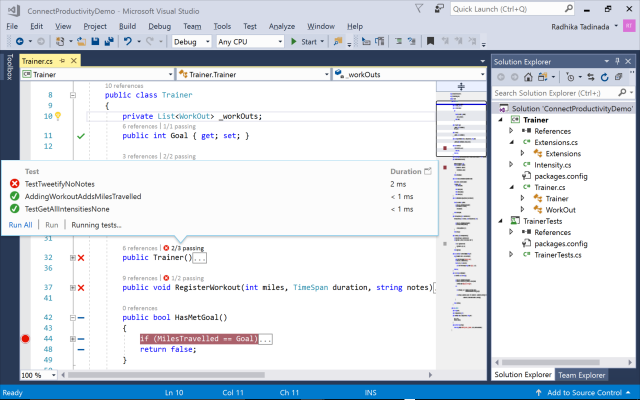Because Microsoft's Visual Studio only runs in the Windows environment, however, it is impossible to use Visual C++ directly on a Macintosh. We should point out that by installing VirtualPC, a Macintosh user may create a Windows simulator on their machine and thereby run Microsoft Visual C++. Mar 07, 2017 Now we have two Visual Studio versions (Visual Studio for Mac, Visual Studio Code) that can directly install on the Mac (macOS), refer to your description, it looks like you installed the Visual Studio for Mac, it is a developer environment optimized for building mobile and cloud apps with Xamarin and.NET.
Visual Studio for Mac was released just under two months ago at Build 2017, and already we’ve seen tremendous growth in .NET developers working on the Mac. Visual Studio for Mac enables you to build native apps for macOS, native mobile apps for iOS, tvOS, watchOS, and Android, using Xamarin and Xamarin.Forms; and web sites and services using ASP.NET Core. You can also use Unity to build cross-platform 3D games.
To help new Visual Studio for Mac developers get started, we’ve created some hands-on labs to walk through some of its exciting new features. The first two labs are available today, for Unity game development and connecting to Internet of Things (IoT) devices, and we’re planning to release 4 more in the coming weeks.
Lab 1: Building Games with Unity in Visual Studio for Mac
The first hands-on lab demonstrates how to build and debug Unity game projects. It guides you through 4 tasks:
- Setting up a basic Unity project
- Working with a 3D game scene
- Debugging the game script
- Exploring additional features that support game development.
Follow these instructions to download and install Unity, then use it with Visual Studio for Mac to script and debug a 3D game scene.
Lab 2: Targeting IoT Devices in Visual Studio for Mac
Our second lab shows you how to create apps that run on an IoT device – such as the popular Raspberry Pi – from Visual Studio for Mac. It guides you through 3 tasks:
- Setting up your Raspberry Pi
- Creating the IoT project
- Extending your IoT app with Xamarin components to add additional features.
This functionality is currently in preview, but we’ll make sure to update the lab if any changes will be necessary when we ship it in a stable release.
Follow these instructions to write your first IoT code, then visit our IoT samples for more ideas.
Get Started
Download Visual Studio for Mac today, and visit our labs repo on GitHub to give game development a try or connect to an IoT device. With the Community Edition it is easy and free to get started. Keep an eye on this blog for more labs that demonstrate all the other great features of Visual Studio for Mac.
| Craig Dunn, Principal Program Manager @conceptdevCraig works on the Mobile Developer Tools documentation team, where he enjoys writing cross-platform code for iOS, Android, Mac, and Windows platforms with Visual Studio and Xamarin. |
Visual Studio for Mac can be used to build applications and create assemblies during the development of your project. It's important to build your code often to allow you to quickly identify type mismatches, erroneous syntax, misspelled keywords, and other compile-time errors. By building then debugging, you can also find and fix run-time errors such as logic, IO, and divide-by-zero errors.
A successful build means the source code contains correct syntax and all static references to libraries, assemblies, and other components can resolve. The build process produces an application executable. This executable may then be tested via debugging and different kinds of manual and automated tests to validate code quality. After your application is fully tested, you can compile a release version to deploy to your customers.

On the Mac, you can use any of the following methods to build your application: Visual Studio for Mac, MSBuild command-line tools, or Azure Pipelines.
| Build Method | Benefits |
|---|---|
| Visual Studio for Mac | - Create builds immediately and test them in a debugger. - Run multi-processor builds for C# projects. - Customize different aspects of the build system. |
| MSBuild command line | - Build projects without installing Visual Studio for Mac. - Run multi-processor builds for all project types. - Customize most areas of the build system. |
| Azure Pipelines | - Automate your build process as part of a continuous integration/continuous delivery pipeline. - Apply automated tests with every build. - Employ virtually unlimited cloud-based resources for build processes. - Modify the build workflow and create build activities to perform deeply customized tasks. |
The documentation in this section goes into further details of the IDE-based build process. For more information about building applications via the command line, see MSBuild. For details on building applications with Azure Pipelines, see Azure Pipelines.
Note
This topic applies to Visual Studio for Mac. For Visual Studio on Windows, see Compile and build in Visual Studio.
Building from the IDE
Visual Studio for Mac lets you create and run builds instantly, while still giving you control over build functionality. When you create a project, Visual Studio for Mac defines a default build configuration that sets the context for builds. You can edit default build configurations and also create your own. Creating or modifying these configurations will automatically update the project file, which is then used by MSBuild to build your project.
How To Use Visual Studio Community
For more information regarding how to build projects and solutions in the IDE, see the Building and cleaning Projects and Solutions guide.
Visual Studio For C++ Download
Visual Studio for Mac can also be used to do the following:
Change the output path. This is edited in your Project's options:
Change the verbosity of the build output:
Add Custom Commands before, during, or after Building or Cleaning: